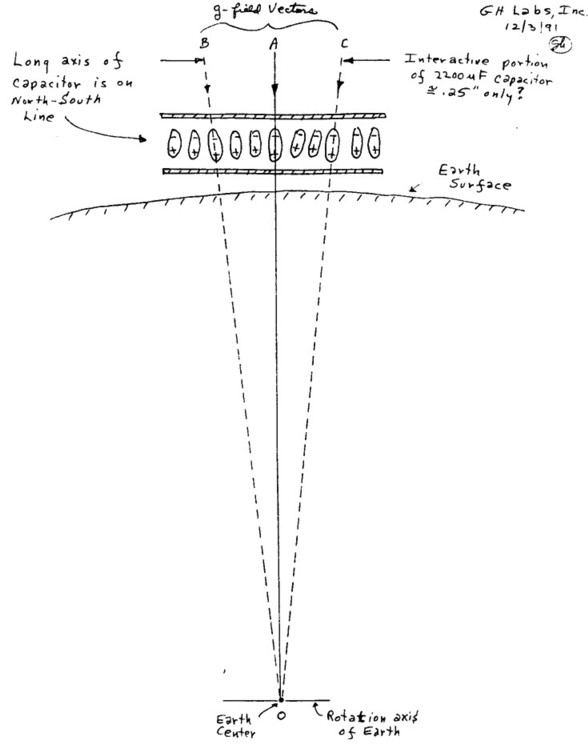A Simplified Presentation of Rustrak Scanning
( 12-3-1991 )

Remarks:
1. The detector capacitor is already ‘pre-polarized’ with the polarization a function of the capacitor geometry. For tubular capacitors, the earth g-fields will interact with only a small segment of the capacitor as depicted here. If the capacitor were oriented in the East-West direction, the tighter radial E-fields would show less interaction.
2. As the capacitor ‘drift scans’ with the earth’s rotation, the detector will respond to a small sector of the universe as determined by the angle B-O-C. A larger active capacitor section would thus scan a proportionately larger sector of the universe.
3. Cosmic events are continually modulating the many g-field vectors along the meridian line in sector B-O-C. There is no interaction seen in the vectors along a latitude line.
4. In the simple Rustrak tests, the ‘fast’ novae and super-novae’ type responses are used as a ‘sweep frequency’ to move the Rustrak needle above and below a reference line (which is the zenith-nadir line A-O) shown here. During these sweeps, the cosmic responses are still superimposed on the Rustrak needle responses. As the needle swings across this sector, the 2-second meter ‘slam’ will reflect the charge condition in the capacitor for the particular g-field vector which is in line with that needle position. For example, a very dense GW ‘shadow’ at such a position will result in a ‘fast’ needle movement at that position, increasing the odds that the ‘slam’ will ‘miss’ such a spot --- leaving a ‘bare’ spot as a sign of dense mass.
5. In practice, the GW detector will respond to ‘signals’ above and below the earth, as well as strong signals well off the zenith-nadir line (on the meridian); thus further analysis of the responses are required. The responses are further ‘confused’ in that the earth in its cosmic journey will ‘vector scan’ a slightly different sector of the universe daily. Only the very dense structures will tend to repeat on a daily basis.
6. The use of novae for the sweep frequency will result in purely random sweeps --- thus the response should be free of artifacts. Use of circuit oscillations or injected signals as sweeps would probably result in artifacts here.